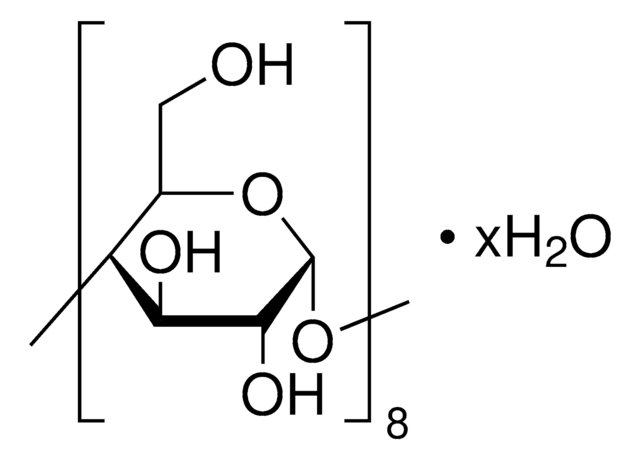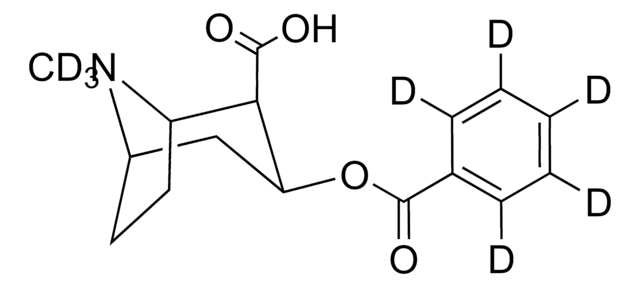C4892
γ-Cyclodextrin
≥98%
Synonym(s):
gamma-Cyclodextrin, Cyclomaltooctaose, Cyclooctaamylose, Schardinger γ-Dextrin
About This Item
Recommended Products
biological source
microbial
assay
≥98%
form
powder
technique(s)
HPLC: suitable
solubility
1 M NH4OH: 50 mg/mL
SMILES string
[H][C@]1(O[C@H](COC(C)=O)[C@@H](OC(C)=O)[C@H](OC(C)=O)[C@H]1OC(C)=O)O[C@@H]2[C@@H](COC(C)=O)O[C@H](OC(C)=O)[C@H](OC(C)=O)[C@H]2OC(C)=O
InChI
1S/C48H80O40/c49-1-9-33-17(57)25(65)41(73-9)82-34-10(2-50)75-43(27(67)19(34)59)84-36-12(4-52)77-45(29(69)21(36)61)86-38-14(6-54)79-47(31(71)23(38)63)88-40-16(8-56)80-48(32(72)24(40)64)87-39-15(7-55)78-46(30(70)22(39)62)85-37-13(5-53)76-44(28(68)20(37)60)83-35-11(3-51)74-42(81-33)26(66)18(35)58/h9-72H,1-8H2/t9-,10-,11-,12-,13-,14-,15-,16-,17-,18-,19-,20-,21-,22-,23-,24-,25-,26-,27-,28-,29-,30-,31-,32-,33-,34-,35-,36-,37-,38-,39-,40-,41-,42-,43-,44-,45-,46-,47-,48-/m1/s1
InChI key
GDSRMADSINPKSL-HSEONFRVSA-N
Looking for similar products? Visit Product Comparison Guide
General description
Application
- A catalyst to synthesize substituted isoxazolidines via 1,3-dipolar cycloaddition of nitrones with styrenes and cinnamates.
- An organic ligand to synthesize cyclodextrin-based metal-organic frameworks using biocompatible metal ions.
- A reactant to synthesize O-perallylated cyclodextrins via perallylation with allyl halides in the presence of NaH.
Features and Benefits
- Green and environment-friendly
- No biological toxicity
- Biodegradable
Storage Class
13 - Non Combustible Solids
wgk_germany
WGK 1
flash_point_f
Not applicable
flash_point_c
Not applicable
ppe
Eyeshields, Gloves, type N95 (US)
Choose from one of the most recent versions:
Certificates of Analysis (COA)
Don't see the Right Version?
If you require a particular version, you can look up a specific certificate by the Lot or Batch number.
Already Own This Product?
Find documentation for the products that you have recently purchased in the Document Library.
Customers Also Viewed
Articles
Techniques for solubilizing metabolically important compounds in aqueous solutions are reviewed.
Our team of scientists has experience in all areas of research including Life Science, Material Science, Chemical Synthesis, Chromatography, Analytical and many others.
Contact Technical Service






